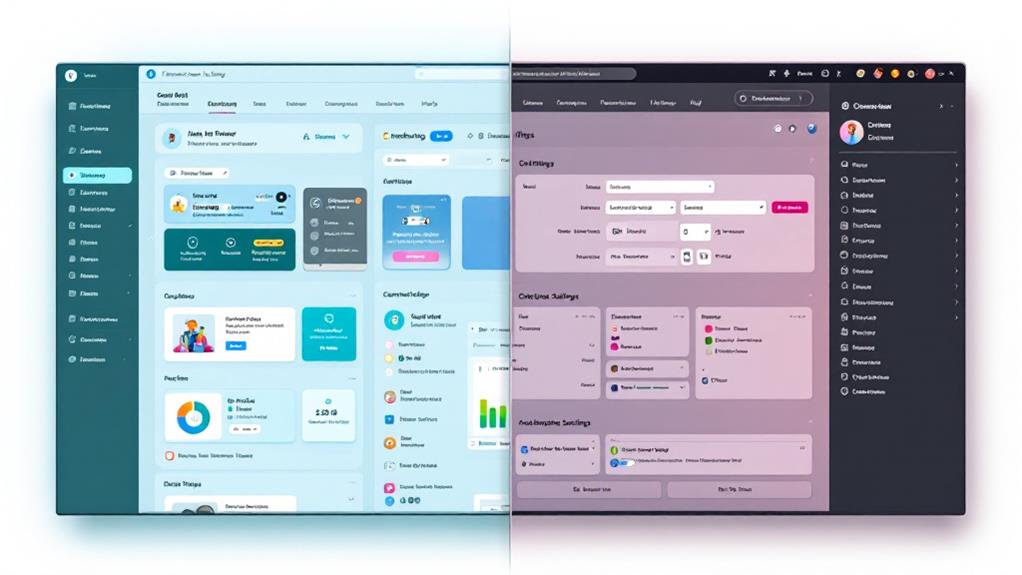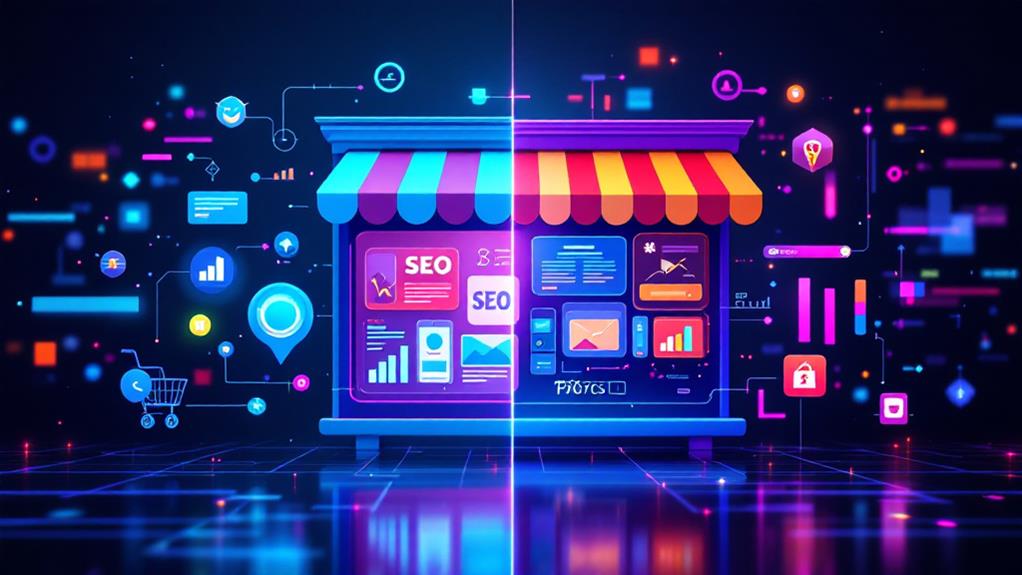When comparing Shopify and Prestashop, you'll notice distinct differences in ease of use, pricing, customization, and other aspects that impact your ecommerce strategy. Shopify offers a user-friendly interface with drag-and-drop features, making it beginner-friendly, whereas Prestashop is more flexible but requires technical skills. Shopify's subscription model provides predictable costs, while Prestashop is free but incurs additional expenses for hosting and customization. Both platforms offer SEO capabilities, but Shopify's built-in payment system simplifies transactions compared to Prestashop's third-party modules. Additionally, Shopify's extensive app ecosystem and 24/7 support outshine Prestashop's community-based assistance. Explore each difference to evaluate what suits your needs.
Ease of Use

When it comes to ease of use, everyone appreciates a platform that's intuitive and straightforward. Shopify excels in this area, designed with a user-friendly interface that even beginners can navigate comfortably. You'll find that its drag-and-drop functionality simplifies the process of building your online store.
Shopify also offers an extensive range of templates and themes, allowing you to customize your site without needing extensive coding knowledge. Its dashboard is organized logically, making it easy for you to manage inventory, track sales, and analyze customer data efficiently.
Prestashop, on the other hand, offers flexibility, but it might require a steeper learning curve. It's an open-source platform, meaning you can tailor your store extensively if you possess technical expertise.
While its backend might seem complex initially, it provides detailed control over your store's features. Prestashop's modular system allows you to add functionalities via modules, granting you in-depth customization options. However, you might find it less intuitive than Shopify, especially if you're not familiar with web development.
Pricing Structure
Comparing the pricing structures of Shopify and Prestashop, you'll find distinct approaches that cater to different needs.
Shopify operates on a subscription-based model, offering three main plans: Basic, Shopify, and Advanced. These plans range from $39 to $399 per month, providing varying levels of features like analytics, staff accounts, and shipping discounts. Shopify also charges transaction fees unless you use Shopify Payments, which can add to your costs. This predictable pricing can simplify budgeting for startups and established businesses alike.
In contrast, Prestashop is an open-source platform, meaning it's free to download and use, making it an attractive option if you're looking to minimize initial expenses. However, you'll need to take into account hosting fees, domain registration, and potential costs for themes and modules. These additional expenses can vary widely, depending on your specific requirements and chosen providers.
Unlike Shopify, Prestashop doesn't impose transaction fees, which can be advantageous if you process a high volume of sales.
Both platforms have their merits, with Shopify's straightforward pricing offering convenience, while Prestashop's flexibility allows for potentially lower costs.
Ultimately, the choice will depend on your budget, technical expertise, and long-term business goals.
Customization Options

Customization is a crucial factor when choosing between Shopify and Prestashop, as each platform offers unique options to tailor your online store.
Shopify provides a user-friendly environment, allowing you to customize your store with ease. It offers a range of themes and apps, which can be modified through a simple interface.
Prestashop, on the other hand, is an open-source platform, giving you more freedom to tweak and personalize every aspect of your store's design and functionality. This requires a bit more technical knowledge but allows for greater flexibility.
Here are three main differences in customization options between Shopify and Prestashop:
- Themes and Templates: Shopify offers a variety of professionally designed themes that are easy to customize with drag-and-drop tools. Prestashop provides a plethora of templates, but customizing them often involves editing code.
- Apps and Modules: Shopify's app store features numerous add-ons to enhance your site, with many options for automation and marketing. Prestashop's modules offer similar functionality but require more configuration.
- Code Access: Shopify limits code access for certain changes, while Prestashop allows full access, enabling more advanced customizations for those with coding skills.
Payment Gateway Integration
Payment gateway integration is an important aspect of running an online store, as it directly affects how you receive payments from customers.
When choosing between Shopify and Prestashop, it's vital to understand their differences in this area. Shopify boasts a built-in payment gateway called Shopify Payments, which simplifies the process by allowing you to manage transactions directly through your store without needing third-party integrations. This can save you time and reduce transaction fees. Additionally, Shopify supports over 100 external payment gateways, giving you flexibility if you prefer other options like PayPal or Stripe.
Prestashop, on the other hand, relies heavily on third-party payment modules. While this can offer more customization, it requires additional steps to integrate and manage these gateways. You may need to evaluate extra costs for certain payment modules, which can vary depending on the provider.
Prestashop supports a wide range of payment options, including popular choices like PayPal and Authorize.Net, but you'll need to manually integrate them into your store.
Ultimately, Shopify provides a more streamlined approach with its built-in solution, while Prestashop offers greater flexibility through external modules. Your choice will depend on your specific needs and preferences for payment processing.
SEO Capabilities

Search engine optimization (SEO) capabilities are critical for driving traffic to your online store. When comparing Shopify and Prestashop, you'll find distinct approaches to SEO that might influence your decision.
1. Shopify: It provides a user-friendly experience with built-in SEO features, allowing you to easily edit meta tags, titles, and descriptions. Shopify also generates automatic sitemaps, which help search engines index your pages more effectively.
However, it's somewhat limited in advanced SEO customizations due to its closed-source nature.
2. Prestashop: This platform offers more flexibility for SEO, as it's open-source. You can tweak the code to optimize your store's SEO further, granting more control over technical aspects like URL structure.
Prestashop also supports numerous SEO modules and plugins, providing extensive options to enhance your store's visibility.
3. Both Platforms: They support SEO-friendly URLs, alt text for images, and basic analytics. However, the extent of customization and control you have may vary, with Prestashop offering more depth for those knowledgeable about SEO intricacies.
Ultimately, your choice between Shopify and Prestashop will depend on whether you prefer ease of use with built-in tools or deeper customization and control over SEO elements.
Customer Support
Finding your way through customer support can feel like finding a lighthouse in a storm when running an online store. With Shopify, you gain access to 24/7 customer support, which is essential for addressing issues promptly.
They offer multiple channels for assistance, including live chat, email, and phone support, ensuring you get the help you need when you need it. Their extensive knowledge base and community forums also provide a wealth of information, allowing you to troubleshoot independently if preferred.
In contrast, PrestaShop doesn't offer direct support like Shopify. Instead, it relies on a community-driven approach. You can find assistance through forums and user groups, which are helpful but not as immediate as live support.
PrestaShop also provides a detailed documentation center, guiding you through various processes and potential issues. However, if you seek direct support, you might need to purchase a support plan, which can add to your costs.
When considering customer support, Shopify provides more immediate and varied options, which can be vital for ensuring smooth operations. PrestaShop's community-driven support can be beneficial, but it may not match the immediacy and reliability that Shopify offers.
Third-Party App Ecosystem

The third-party app ecosystem plays an essential role in enhancing the functionality of your online store, and Shopify excels in this area. With a vast selection of apps, Shopify's app store offers you numerous options to extend your store's capabilities.
Compared to Prestashop, Shopify provides more extensive choices, helping you integrate various features without needing advanced technical knowledge. This flexibility makes it easier for you to tailor your store to meet specific business needs.
When considering the third-party app ecosystem, you should note the following:
- App Variety: Shopify's app store hosts thousands of apps, ranging from payment gateways to marketing tools, which can greatly enhance your store's operations.
- Prestashop, while offering a decent selection, doesn't match Shopify's breadth.
- Ease of Integration: Shopify's apps are designed for straightforward integration, allowing you to quickly add new features to your store.
- In contrast, Prestashop may require more technical knowledge, especially for complex integrations.
- Support and Updates: Shopify apps typically receive regular updates and support from developers, ensuring compatibility with new platform features.
- Prestashop's app updates may vary, occasionally leading to compatibility issues.






















































